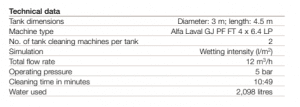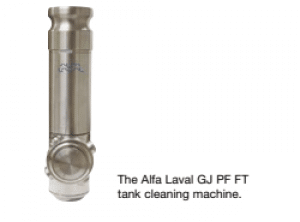A European brewery was awarded a major contract to brew a well-known beer brand. With this contract came the need to optimize various areas in the brewery process. Optimization of the existing cleaning-in-place (CIP) regime was among these processes.
The brewery’s existing horizontal fermenters had been in service for many years. An audit of the existing CIP regime revealed that replacing the existing rotary spray heads with rotary jet head technology would result in substantial savings and significant operational and business benefits. Switching to rotary jet head technology would reduce downtime, shorten the cleaning cycle time, optimize CIP performance, reduce water consumption and minimize chemical use.
Rotary jet head retrofit optimizes cleaning efficiency. The brewery worked with an Alfa Laval Master Distributor to discuss the brewery’s cleaning requirements, including the need to keep any proposed retrofit of a more efficient cleaning head technology both simple and cost-effective.
Given the dimensions and the existing cleaning-head inlet connections of the 30 horizontal fermentation vessels, it was clear that any retrofit would require the use the existing inlet connections to minimize production loss as well as downtime. At just 4″ in diameter, the inlet connections were quite small to be able to upgrade to the typical rotary jet head.
The solution? The Alfa Laval GJ PF FT, a high-impact rotary jet head tank cleaning device, which is part of Alfa Laval’s comprehensive tank cleaning machine portfolio. All the tank cleaning machines in the Alfa Laval GJ product line are designed for a small tank inlet. The Alfa Laval GJ PF FT easily fits through the existing 4″ tank opening.
In addition, the Alfa Laval Master Distributor recommended the brewery to use the Alfa Laval TRAX simulation technology to determine the optimal configuration. Based on the simulation, a four-nozzle tank cleaning device sized to match the existing flow rate requirement of 6 m³/h was selected.
Optimization for repeatable first-class CIP performance. By optimizing wetting intensity, pattern mesh width and cleaning jet velocity – the three key parameters to cleaning a vessel, Alfa Laval was able to guarantee repeatable first-class CIP performance with minimal requirements to drain water during the prerinse phase. Alfa Laval also was able to guarantee minimal contamination of the detergent tank due to the removal of all of the yeast and residues during the pre-rinse.
The Alfa Laval GJ PF FT rotary jet head combines pressure and flow to create high impact cleaning jets as the nozzles rotate in a precise 360° indexed cleaning pattern around both the vertical and horizontal axes. This guarantees reliable and repeatable cleaning performance. After the initial cleaning trials, it was obvious that there were impressive improvements in the cleaning performance – even at the lower pressure of 3 bar that could only be ramped up upon completion of the retrofit.

Quick and easy retrofit. An excellent choice for retrofits, the Alfa Laval GJ PF FT fits through most existing openings, including the 100 mm openings in the brewery fermentation tanks. No modification of the existing top-entry nozzle openings was required. This eliminated reworking the tank, enabling a quick, cost-effective upgrade. High-impact, low-profile quad-nozzle rotary jet heads were configured to the current operating conditions with a total CIP flow rate of 12 m³/h per fermentation tank. The machines were replaced in a few weeks. The brewery chose to maintain the existing pressure during this replacement process. Although satisfactory cleaning results were achieved with a pressure of 3 bar, the brewery subsequently chose to upgrade the pressure to 5 bar as recommended in the specifications.
Less downtime. Compared to rotary spray head tank cleaning devices, the Alfa Laval GJ PF FT rotary jet heads reduce both the cleaning time and the use of energy, water and cleaning agents. This makes it possible for the brewery to spend less time on maintaining the equipment and cleaning the tanks – and more time producing beer.
Benefits
- High reliability
- Low maintenance
- Media driven
- Hygienic design
- Optimal cleaning
- High-impact 360° cleaning
- Quick return on investment
Improved product quality. With the tanks so clean, the brewery is confident that no impurities are left in the tanks when starting a new fermentation batch.
“We’ve never seen the fermenters this clean before,” says the chief engineer at the brewery.
Completely clean tanks are crucial for the quality of the beer to prevent the risk of cross-contamination from yeast strains. This is promising for the brewery’s future.







